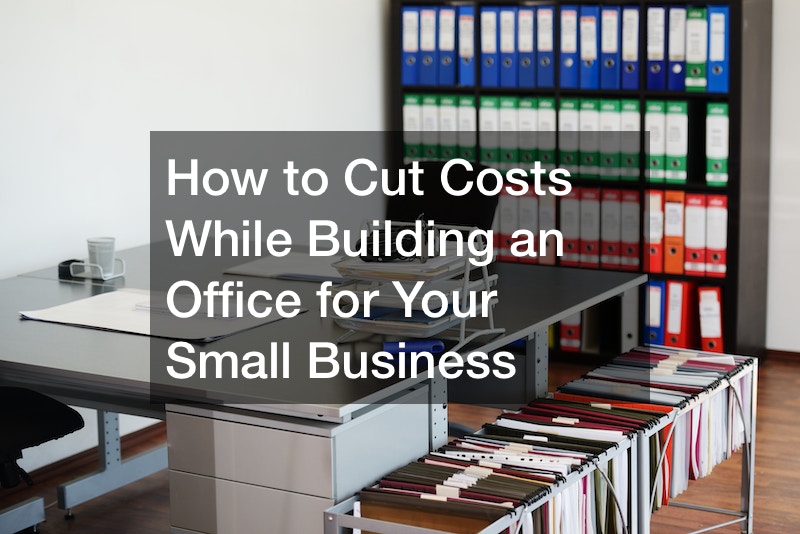
No matter which activity you are partaking in, it’s helpful to have a designated area for it. While the pandemic has proven that remote working is feasible, office working remains beneficial to business in ways such as creating an organizational culture. Company culture, which has a proven impact on a business’s performance, is much easier to foster when employees are present in the same space.
Also, many employees enjoy working from home but want to interact with their coworkers – hence the rising popularity of hybrid work models. According to an Accenture report, 63% of high-growth companies use hybrid work models. It’s a model that’s embraced even the younger Gen Z population, 74% of whom reported that they would prefer some form of on-site work experience. The definition of what an office should be has changed, but small businesses still stand to benefit from having one. Here are 11 ways you can cut costs while building an office for your small business.
1. Figure Out Your Costs
It’s unlikely that you have a mountain of money to work with, so you must figure out your finances. Going over budget is a common occurrence with construction projects. You can mitigate this problem by carefully planning for both expected and unexpected costs. In this regard, a qualified project manager will be of great help as they oversee various parts of the entire project. They can also help you avoid the pitfalls of inaccurate project estimates that can throw a project’s costs into disarray.
As you figure out your finances, consider the shape of your business as well. Knowing your business’s current and projected profits can help you determine whether this is the right time to build. How much money is the bank willing to lend you for your new office? Assessing the financial health of the business, sources of finance, project costs, and project timeline can help you decide whether to go ahead. In construction, there are hard expenses (e.g., materials like commercial concrete, labor, and equipment) and soft expenses (less tangible and sometimes hard to account for expenses such as interest from loans, insurance, and taxes). Plan for both to save time and money. It will also help you keep your project streamlined, prioritized, and on track.

2. Choose a Good Contractor
When building an office for your small business, don’t just choose the lowest bid from a contractor, as it may not be the bargain you think it is. You may be pleased by the savings at first, only to discover shoddy workmanship that costs the business more money in the long run. The contractor is responsible for the physical construction of the office. Some of what they do includes hiring subcontractors, buying materials, coordinating the construction, monitoring the schedule, and even providing temporary on-site facilities such as a restroom trailer. They need to be competent and trustworthy; otherwise, you may have a mess on your hands. While you are looking to cut costs, this is one area where cutting costs can seriously backfire when building an office for your small business. You need to ask:
- Is the lowest bidder including all the costs – if you receive a suspiciously low bid, it could be that the contractor is trying to get your business only for them to spring a surprise cost increase later on. It can also mean they are willing to rush the work, use low-quality labor, or frustrate you. That’s why it’s essential to compare quotes.
- Is the contractor legitimate — contractors need to be licensed and insured; otherwise, you could land in big trouble if someone is injured during work. Some may not acquire the necessary permits or do their due diligence, which can cost your finances and reputation.
3. Value Engineering
Value engineering refers to systematically assessing the costs of a project and looking for areas where costs can be lowered without sacrificing functionality. It involves looking at the building features, equipment, systems, and material choices for areas where savings can be made while maintaining or enhancing the quality and functional performance. The two stages where value engineering can yield the greatest benefits are the planning and design stages. To do so in later stages of construction can produce a net loss. Value engineering helps to maximize functionality at the lowest possible cost.
However, safety should never be compromised in search of cost-cutting. To do proper value engineering, you need to have construction knowledge, reliable cost information, and teamwork. This means you need contractors, architects, designers, project leads, engineers, and others in order to decide how to achieve great results at a lower cost. The coronavirus led to uncertain material prices that have sent budgets skyrocketing, making it even more necessary to value engineer.

4. Tenant Improvement Allowance
The tenant improvement allowance (TI or TIA) is the amount the landlord provides the tenant to cover all or a part of the construction costs. The TIA is usually expressed in terms of square footage. For example, the landlord can offer $20 per square foot, meaning that for a 2,500-square-foot commercial space, they will reimburse the tenant $50,000. The tenant improvement allowance usually covers all building expenses but not other costs, such as furniture. Or other moving/startup costs, e.g., commercial washing machine sales. TIA covers costs directly related to construction. As such, this can include:
- HVAC, electrics, and plumbing
- Painting and carpeting
- Walls and framing
- Space plans
- Permit fees
- Construction drawing
However, it cannot cover:
- IT cabling
- Moving expenses
- Furniture
Landlords are unlikely to pay for items that won’t benefit the next tenant. If you need to transition your company files from physical servers, you’ll have to pay for that yourself. It’s important to negotiate with the landlord and be clear about the terms and conditions of the TIA. Hiring a project manager before signing a lease is a great help in this regard, as they can help you negotiate a high tenant improvement allowance. This means you will have fewer out-of-pocket expenses once you start building an office for your small business.
It’s important to note that the landlord only pays after the project is complete. The tenant will have to foot the bill for construction initially. Once the buildout is complete, you will need to provide receipts, waivers, liens, and other financials detailing the costs incurred. The amount of TIA one can receive varies depending on the business, the state of the space (an unfinished shell space will have a higher allowance), and other features of the lease. You should be prepared to provide financial information to the landlord, and you can also get a higher TIA f you commit to a longer lease.
5. Turn Key Renovations
This is an alternative to tenant improvement allowance. It means that the landlord will pay for all the construction costs leaving the tenant to pay for items such as furniture and phones. The landlord will build the space following the plans and cost estimates provided by the tenant. If your landlord is willing to construct the office, they will deliver it to you as a condition of the lease. However, you must be careful to ensure the buildout is up to par.
This works well when the project is limited in scope though you should be careful because the buildout costs will be buried in your lease rate. You get to cut immediate costs by paying the construction costs over the lease period, but you need to hire an experienced project manager so that the TI amount in your lease is adequate. Alternatively, you can also cut costs by negotiating rent abatement, which means you get a rent discount on tenant improvements that you oversee.
6. Recycle
If you are building an office for your small business in a previously occupied space, try using as many parts of the prior build as you can. If there are elements you like about the existing space, try and keep them. You save a lot of money by not changing the structural parts. Instead, you can make it your own by changing the paint, fixtures, branding, and other surface elements.
7. Porous Asphalt Pavement Tax Credits
Unlike traditional impermeable asphalt, porous asphalt allows water to pass through it into the stone bed below. It’s an environmentally friendly way to manage stormwater since it reduces the chances of flooding and runoff water polluting aquifers. Some states offer tax credits to companies with permeable pavements, so you can inquire with the local parking lot paving services to find out. In addition, some municipalities will charge property owners for stormwater runoff that overwhelms storm sewers, so if you own the land, you can save money by eliminating these fees. Permeable pavement also removes the need to install retention ponds allowing you to use the freed-up land to add value to your property.

8. Install a Commercial Fence
Security is a crucial part of building an office for your small business. Businesses need control over who can enter the premises for the safety of the property and employees. You can save money by keeping thieves at bay and ensuring employee safety. Commercial fence installation companies can install controlled access points that guide movement through your offices and deter potential criminals.
During construction, various materials, tools, and equipment will be kept on-site, so even then, you may require a fence to safeguard your property. Save money by renting a temporary fence. Fences have other benefits, including improved privacy, higher property value, and better aesthetics. Depending on your tastes, you can choose from many permanent fence types, including chain link, iron, wood, vinyl, steel, and aluminum.
9. Wired or Wireless
Planning ahead can help you avoid incurring any unnecessary costs. Before installing any cabling, consider first the needs of your office. If your business can work wirelessly, you can save money by not wiring your office premises for internet and landlines. Instead, budget to install excellent Wi-Fi services. To save money while building an office for your small business, you need to intentionally plan every detail to suit your business. Professionals such as project managers and even paving contractors can help you decide on the most cost-effective approaches.

10. Going Solar
You can cut costs by installing equipment that will save you money in the long run. According to an EnergySage report, the average commercial property owner can reduce 75% of their energy costs via commercial solar installation. Commercial property owners pay an average monthly electric bill of $1,950. Some installed solar and had their bill reduce to $500. Businesses can even pay for the cost of solar over an extended term via a Power Purchase Agreement (PPA). The solar provider installs the solar system and gets paid for the energy the business consumes at a predetermined rate.
11. Commercial Security System
Purchasing a commercial security system for your business not only protects your assets and employees but can also reduce your insurance premiums. Security companies like ADT offer everything from commercial fire alarm installations to surveillance to cybersecurity solutions. Installing one of these demonstrates a commitment to security that many insurance companies will honor by offering discounted premiums. A security system can also protect businesses from insider employee theft, a crime that costs American businesses $50 billion every year.
Proper planning is key to cutting costs when building an office for your small business. That’s part of what makes project managers, commercial contractors, and other professionals a critical part of any construction project. These experts will continue to save you money throughout the project’s lifespan and provide skills such as problem-solving, scheduling, quality workmanship, value engineering, and so on. They are an invaluable resource you can rely on to keep everything on track and achieve set goals. If you need help cutting costs, reach out to us today.



